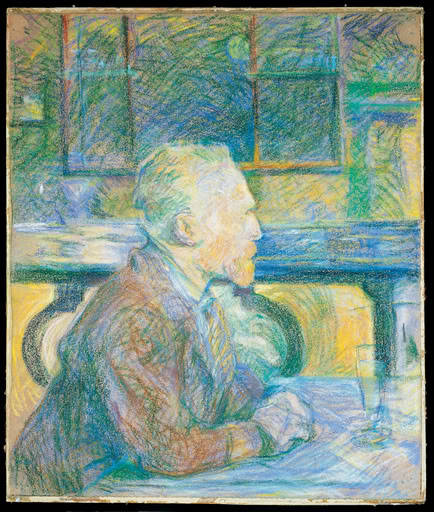Drinking AbsintheVincent van Gogh, pastel drawing by Henri de Toulouse-LautrecArnold (1988) has furt
Drinking AbsintheVincent van Gogh, pastel drawing by Henri de Toulouse-LautrecArnold (1988) has further suggested that Van Gogh’s fondness for absinthe developed into a generalized craving for thujone and related terpene molecules. Van Gogh is known to have used large amounts of camphor (another terpene) in an attempt to treat insomnia. Furthermore, there are several instances of bizarre behavior which (attempts to eat paint and drink turpentine and kerosene) Arnold sees as evidence for this craving. Although this idea is interesting, there is no strong evidence that terpenes are addictive in this manner. I also wonder if Arnold is not reading too much into Van Gogh’s behavior. Not every action of mentally ill or delirious individuals can be explained, after all. Still, even if Van Gogh were only addicted to the alcohol in absinthe, such an addiction could conceivably have kept Van Gogh see-sawing between alcohol withdrawal and porphyric attacks.Other authors have focused on Van Gogh’s paintings and whether his illness or drug use might have contributed to his creativity. One theory (Lee 1981) is that the bright yellow hues and character of his later works were the result of digitalis intoxication, which can produce xanthopsia (yellow vision) and coronas (glowing haloes around objects). Although there is no definite record of Van Gogh receiving this drug, it was used as a treatment for epilepsy and Van Gogh twice painted his physician holding a fox glove (Digitalis purpurea) plant, from which digitalis is extracted. Santonin, which is found in low concentrations in Artemisia absinthium and Artemisia pontica, is also known to cause xanthopsia. However, Arnold and Loftus (1991) have determined that the amount of santonin in absinthe would have been insufficient to produce xanthopsia. Santonin therefore cannot be an explanation for Van Gogh’s painting style, while digitalis may have played some role.In general, I think this type of speculation on the contribution of drugs and illness to art is unproductive. It often seems to rely on an underlying assumption that breaks from ‘realistic’ representation require some explanation other than the artist’s intent. Despite these reservations, I think a case can be made that Van Gogh’s experience with mental illness and absinthe intoxication may have influenced his painting. As Arnold and Loftus (1991) write: …novel experiences of relative sizes, shapes, and colours perceived under the influence of absinthe may have been recalled later and incorporated into new and daring compositions, perspectives, and palettes (p. 507).Other artists have been known to find inspiration in drug use. However, the connection between creativity and drug intoxication is complex. Drug taking is a social activity. At the same time as an artist is taking a drug, he or she is often interacting with some social group with its own beliefs, behaviors, and aesthetics. When Van Gogh began to drink absinthe, he probably did so in a cafe frequented by writers and artists. It is impossible to separate the artistic influence of that stimulating social environment from whatever effects absinthe could have had on his perception and creativity.Source:www.plantteacher.com -- source link
Tumblr Blog : huariqueje.tumblr.com
